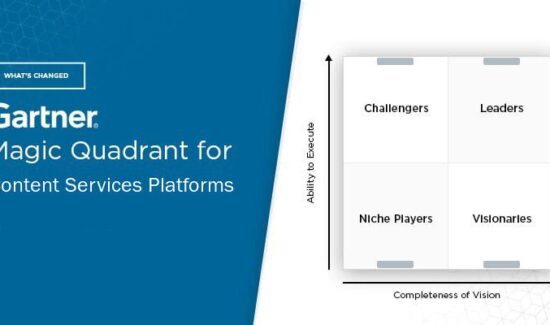What’s Changed: 2018 Gartner Magic Quadrant for Web Content Management

 Gartner has officially released its 2018 Magic Quadrant for Web Content Management. According to Gartner, web content management (WCM) is defined as “the process of controlling content consumed over one or more digital channels through the use of specific management solutions based on a core repository. These solutions may be procured as commercial products, open-source tools, cloud services or hosted services.”
Gartner has officially released its 2018 Magic Quadrant for Web Content Management. According to Gartner, web content management (WCM) is defined as “the process of controlling content consumed over one or more digital channels through the use of specific management solutions based on a core repository. These solutions may be procured as commercial products, open-source tools, cloud services or hosted services.”
Functions of WCM solutions include, but aren’t limited to, content creation capabilities, library services, repositories that organize and provide metadata about content, website management features, content deployment, and the ability to integrate well with delivery platforms.
In this Magic Quadrant, Gartner evaluates the strengths and weaknesses of 18 providers that it considers the most significant in the marketplace, and provides readers with a graph (the Magic Quadrant) plotting the vendors based on their ability to execute and their completeness of vision. The graph is divided into four quadrants: niche players, challengers, visionaries, and leaders. At Solutions Review, we read the report, available here, and pulled out the key takeaways.
This Magic Quadrant for Web Content Management features minimal changeover, as only one provider from the past year was dropped, and only one was added. GX Software no longer meets Gartner’s inclusion criteria and was removed as a result. The new vendor, WP Engine made its debut in the niche players section of the graph.
The leaders of the report remain unchanged for the most part, with the exception of OpenText, which shifted from the challenger category by improving its completeness of vision. This jump by the vendor seems to be affected by its capabilities in security and integration, which better equip it to support customers through their life cycle. The placements of the remaining leaders, Sitecore, Adobe, Acquia, Episerver, Oracle, IBM, and BloomReach stayed relatively static compared to the previous year.
The only new provider this year, WP Engine, is categorized as a niche player located on the edge of the axis between niche player and challenger. The vendor used the WordPress community as a means to further increase the popularity of its own WordPress based solution, WordPress Digital Experience Platform, which helped it secure its placement on the graph. Squiz and eZ Systems were also classified as niche players this year. eZ Systems uses an established open-source software (OSS) platform in conjunction with commercial backing for support and hosting, which creates high demand in today’s WCM market. Squiz has positioned its tool in the context of the broader space of business transformation, which assists in showing the role of WCM in that transformation.
In the visionaries category, e-Spirit made the move from the niche players section by increasing its completeness of vision. This shift is likely due to the progress the vendor has shown in the capabilities it offers to appeal to business buyers, with functionality directed towards marketers. CoreMedia was also named a visionary, due to its product strategy which displays an in-depth understanding of important market trends. The last vendor in this section is Crownpeak. The provider was scored highly for direct services and support by Gartner reference customers.
Rounding out this Magic Quadrant are the challengers. Aside from OpenText, the four vendors in this category are the same and their placements are mostly unchanged. One of the providers, Automattic offers pricing options such that businesses are able to start small and then expand their solution footprint when needed. Another challenger, Kentico Software, offers a solution that provides native, built-in digital experience management capabilities. Progress’ placement on the Magic Quadrant is likely due to the vendor’s knowledge and background in providing development tools and platforms. Finally, SDL likely earned its spot in the report based on its global reach and expanding partner network.
Read the Full Magic Quadrant for Web Content Management here.
Widget not in any sidebars























